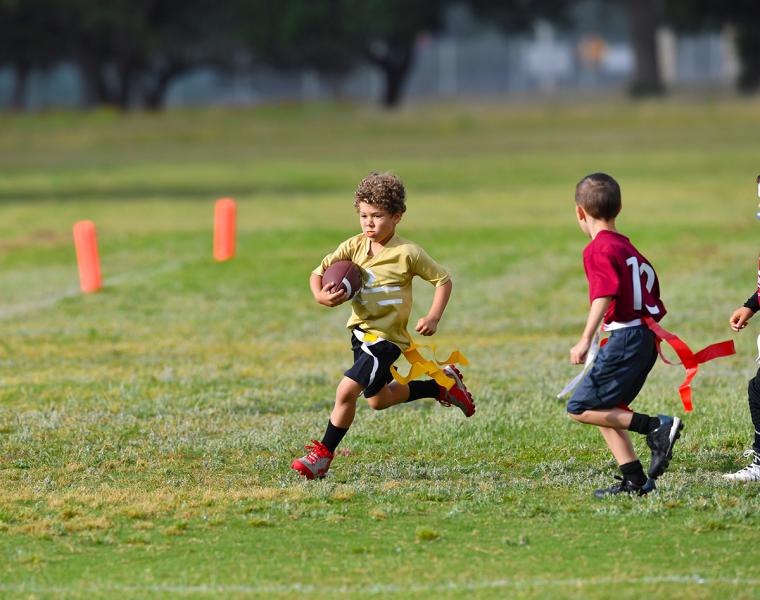
 Football will always be one of the most popular sports offered for kids. It’s a traditional school sport at all ages, and let’s face it, it’s an enormous spectator sport at the pro level.
Football will always be one of the most popular sports offered for kids. It’s a traditional school sport at all ages, and let’s face it, it’s an enormous spectator sport at the pro level.
In youth football, though, the sport has taken some hard knocks (no pun intended) with the bad news about concussions. And as more kids want to stay involved in the sport, and as more parents want to keep them safe, we’re seeing an explosion of popularity in flag football. As a result, a number of organizations have sprung up to try to serve that market. Here is a snapshot of the sport.
What are the Demographics of Football?
We can only speak for ourselves as the United States Flag and Touch Football League (USFTL), but we have reason to believe what we’re seeing is true across the board. We’re seeing a variety of age groups represented, with kids as young as five years old, to our divisions that take in ages 35 and up. We are also seeing women’s teams and co-ed teams, and all those are actively playing. Specifically in the youth divisions, there has been a big uptick in participation, not just in our league but in the other leagues in the marketplace who are our competitors.
The age groupings are interesting, and they tell us a lot about our players. We generally see kids ranging from age five to 13. Then, during the high school years (ages 14-17), there is a drop-off and participation picks up again once they hit adult age. We believe high school kids become preoccupied with varsity sports and activities during those years, and college students who want to play flag football will generally find clubs at school; many of these have championships organized by NIRSA (the National Intramural and Recreational Sports Association).

The Decline of Tackle Football
Overall, we’re seeing declines in the numbers of youth being enrolled in tackle football programs. For example, according to the National Federation of State High School Associations, although football remains the most popular sport for boys, the number of students enrolled in those teams has dropped for the second consecutive year.
The Growing Popularity of Flag Football
It goes without saying that non-contact flag football helps kids avoid injury, but that is one of the reasons it’s popular at the adult level as well. You can play as hard as you want without worrying that you won’t be able to make it to work on Monday morning.
Another reason flag is so popular, at least in our league, is because it offers multiple skill level divisions. Within all our different play formats, we offer A, B, C and D levels of play. You have to make sure you are always serving the lower levels as well because there are far more average and below-average players than elite players. (In fact, our A level divisions are always the smallest and C and D are always the biggest). By playing teams that are more evenly matched, everyone has a better experience.
If you wanted to do it as an equation, you might say for every 10,000 high school football team players, there are 1,000 college team players – and of course, even fewer in the pro leagues. Despite that, everyone involved loves the sport. They want to keep playing and by playing a non-tackle form of the game, they can continue to do so.
Additionally, flag football is offered in a variety of formats; at our national championships, we offer the following:
• Youth 5-on-5 Flag Non-Contact
• 4-on-4 Flag Non-Contact
• 5-on-5 Flag Non-Contact
• 5-on-5 Co-Ed Flag
• 5-on-5 Flag Woman Contact
• 5-on-5 Flag Woman Non-Contact
• 7-Woman Screen Flag
• 8-Woman Eligible Flag
• 8-Man Co-Ed Flag
• 7-Man Rough Touch
• 7-Man Screen Flag
• 8-Man Co-Ed Flag
• 7-Man Non-Contact Flag
• 8-Man Eligible Flag
• 9-Man Ineligible Lineman Flag A
• 9-Man Ineligible Lineman Flag B
There are plenty of options for those who want to play, and this year, we’ve brought back the ‘touch’ version of the game. As a whole, it remains safer than the tackle version of the sport.
 You Mean There’s Actually an Economy When it Comes to Flag and Touch Football?
You Mean There’s Actually an Economy When it Comes to Flag and Touch Football?
There sure is. One of the misconceptions about flag and touch football is that it is just played at the elementary and middle school levels. Not so. There are some very high-level adult teams playing for big money. Over this past summer, one event had a $1 million championship payout to the winning team. (And yes, you read that correctly: a $1 million prize at a flag football tournament.)
The same people who aren’t aware of flag and touch football’s competitive nature are often the same ones who are surprised when they see the sport actually played, or when they play it themselves. Flag is really fun, but it also has a lot of strategy involved, as well as running and throwing. At the top levels, you will really see some excellent play.
As the non-tackle version of the sport has grown, so have the number of leagues and of course, the number of championships. USFTL offers its national championships each year, and we’ve seen them grow to become the largest in the world, hosting 456 teams in January of 2018, with an economic impact of $4.5 million. Our next championships are scheduled for the Championship Sports Complex of Tampa Bay and will be held over the Martin Luther King, Jr. weekend. We have had good luck with Florida destinations, having been to Sarasota and Orlando as well. The tournament is played on Friday, Saturday and Sunday, leaving that Monday open so that kids and their families can explore the city and enjoy the sunshine and the warm weather.
One thing we have noticed is that flag football is a family sport. The kids travel in with their parents and siblings and many of them make a week-long vacation out of it. We set up the tournament in a format that is a hybrid between double elimination and pool play so that each team has one game each day of the tournament. This leaves parents with the feeling they’ve gotten their money’s worth and kids feeling happy because they got to play a few different teams. If you play once and then go home, it’s hardly worth the trip, in many people’s minds.
How Long is the Flag Football Season?
Interestingly enough, there is no one season for flag football, the way there is for high school, college or the pros. Flag football can be (and is) played year-round. Of course, some areas may have an indoor game if their weather doesn’t allow for outdoor play throughout the year; Albany, New York, for example, has a booming indoor league that runs through the winter. Every area needs to find their niche, based on their conditions and the athletes available because the timing of a league is absolutely critical to its success.
As the popularity of flag and touch football grows, there is increasing competition for players and of course, everyone wants to get the most players for their program they can. The pool of players is limited since we are not likely to get crossover from other sports; there aren’t a lot of kids coming into football (flag or tackle) from soccer or basketball, for example. Most of the players coming into flag football are moving over from tackle programs.
Flag and touch football continues to grow in recognition as well. The sport is getting more media impressions and parents are becoming far more aware of it as an option for their kids who want to keep playing. It’s also a great way for former high school and college players to keep their skills sharp and to satisfy that competitive urge. USFTL has been around for four decades now, and in that time, we’ve seen the sport of football face challenges and evolve. It’s good to be a part of it, and we’re looking forward to even more growth in the decades to come. SDM
Odessa, Texas:
The Home of Friday Night Lights
When you hear the phrase “Friday Night Lights,” many refer to the popular movie about the tribulations of a small-town football team in the early 2000s. What many might not know is that it all began right here in Odessa, Texas. High school football reigns supreme over other sports in West Texas.
The rivalries, the community pulling together behind their team and the players who take on opponents on the gridiron for a glimpse at glory, all create the passion behind the legend. The monument that reflects the devotion of West Texans to football is Ratliff Stadium. Built in 1982, it holds 19,302 seats plus standing room only spaces. In autumn, the stadium illuminates the dark West Texas sky as a beacon for all to see.
In Odessa, football is considered a culture, and on Fridays we all unite to experience one beautiful spectacle: Friday Night Lights.
McKinney, Texas:
We Can Host Football – and a Whole Lot More
“Friday night lights” high school football for which Texas is so well known is alive and well in North Texas, receiving a boost recently, thanks to the new McKinney ISD Stadium and Community Event Center. Opening just in time for the 2018 football season to begin, the new 12,000-seat stadium isn’t just for high school football, however, and is available for rentals to other organizations. The MISD began receiving rental inquiries for football tournaments (secondary school, collegiate, etc.), band competitions and more, even before the facility opened.
Additionally, the attached Community Event Center that overlooks the field can accommodate a wide range of events, with seating capacities of up to 500 people in a banquet-style arrangement or a maximum of 800 people in a lecture-style setting.
For more information about rental of the football stadium and attached event facility, contact the McKinney Convention & Visitors Bureau at 888-648-8499 or info@visitmckinney.com.

